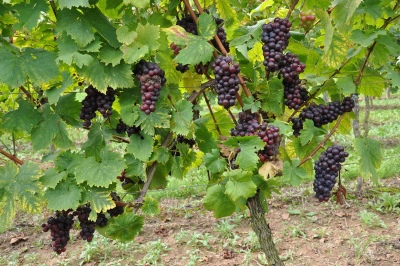
- Appointment: technical
- Berry color: black, with thick prune
- Taste: harmonious, with a slight nutmeg aroma
- With bones: Yes
- Ripening period: mid-late
- Ripening period, days: 137-149
- Frost resistance, ° C: -18
- Name synonyms: Cayaba, Red Frontignan, Muscat Calabah, Muscat Calyabe, Moscato nehru, Muscat a petit gran noir, Rother frontignan, Fekete muscotai
- Bunch weight, g: 75-90
- Yield: 40-100 c / ha
The Black Muscat grape has many synonyms for the name - Cayaba, Red Frontignansky, Fekete muskotai and others.
Breeding history
Until now, the origin of the Black Muscat grapes remains unknown. It is believed to be a mutation of White Muscat. The first mentions of this variety date back to the 19th century. It was first discovered on the Crimean peninsula on the south side.
Geography of distribution
For ripening, it requires a warm climate, therefore it grows mainly in the Crimea and in the south of France. Very capricious to frost, does not have high frost resistance.
Description
The leaves of Muscat are black, rounded, light green in color. The outer surface is not glossy, matt, the leaf dissection is medium. Reddish spots appear on the leaves when the berries are ripe.
This variety is suitable for growing in warm climates. With proper care, it produces a good crop of high quality, which has a good shelf life and high transportability.
Ripening period
In terms of ripening, it belongs to medium-late grape varieties. Usually, the full period is 137-149 days from the ovary to the ripening of the crop. The beginning of ripening is September, but the bunches are harvested later to allow the sugar in the berries to mature.
Bunches
Its clusters are quite dense, cylindrical-conical with small lobes and weigh about 75-90 grams each.
Berries
The fruits of this variety are round, deep black in color with a thick prune, firm to the touch, with a firm skin and tender juicy pulp. Each berry contains 2 to 3 seeds. The diameter of each berry is 15-19 mm, this is considered an average size.
During maturation, their color changes from dark blue to deep black. But the juice of the berries has no color, it is transparent.
Taste
It has a harmonious taste with a weak nutmeg aroma. Since this variety is saturated with sugar, raisins are made from it. With the required aging, up to 30% of sugar will accumulate in the bunches, which makes it possible to make from this variety a red wine "Golden Field" with a wonderful bouquet, which is not inferior to wines from other Muscat grape varieties. It is also combined with the Aleatico grape to obtain the exquisite Black Massandra Muscat wine.
Yield
By the ratio of fruiting shoots and replacing them, usually 61% and 39%, respectively. But over time, replacement buds can give fruit-bearing vines, from which the harvest is subsequently harvested no less than from the main fruiting shoots. The yield of the variety is high and ranges from 40 to 100 centners per hectare of area.


Growing features
This grape variety does not like very moist and highly calcareous soil. It requires a warm climate and moderate watering. And also timely pruning of excess shoots.
Landing
Best planted in a sunny area. The soil should be moderately moist and breathable. They also form small bushes and do not give them large loads.
To harvest the first crop, 4 years must pass from the beginning of planting. Although the very first harvest may appear 2-3 years after planting.

Pollination
Does not require additional pollination, it can self-pollinate due to the presence of flowers of both sexes. The ovary is usually very large, and it gradually turns into a column.
Pruning
This grape variety requires pruning of new shoots. He is not allowed to grow to the sides, as this can affect the quality of the crop.



Frost resistance and the need for shelter
It has a very low frost resistance, therefore it is not suitable for growing in the northern regions. Although later than other nutmegs, it releases buds and is not so strongly exposed to frost. To obtain a good harvest, additional cover for the bushes is required.

Diseases and pests
This type of grape is quite resistant to fungal diseases, for example, to gray mold, and much less often than other Muscat varieties it gets sick with powdery mildew. But it is very susceptible to such diseases as the worm, mildew, it is affected by the grape leafworm.

If a grape is exposed to any disease or insect, this always affects its appearance.
Storage
Its harvested berries tolerate transportation well and can retain their freshness and their presentation for a long time. The crop is stored away from sunlight, preferably in a cool place to extend the shelf life.











































































